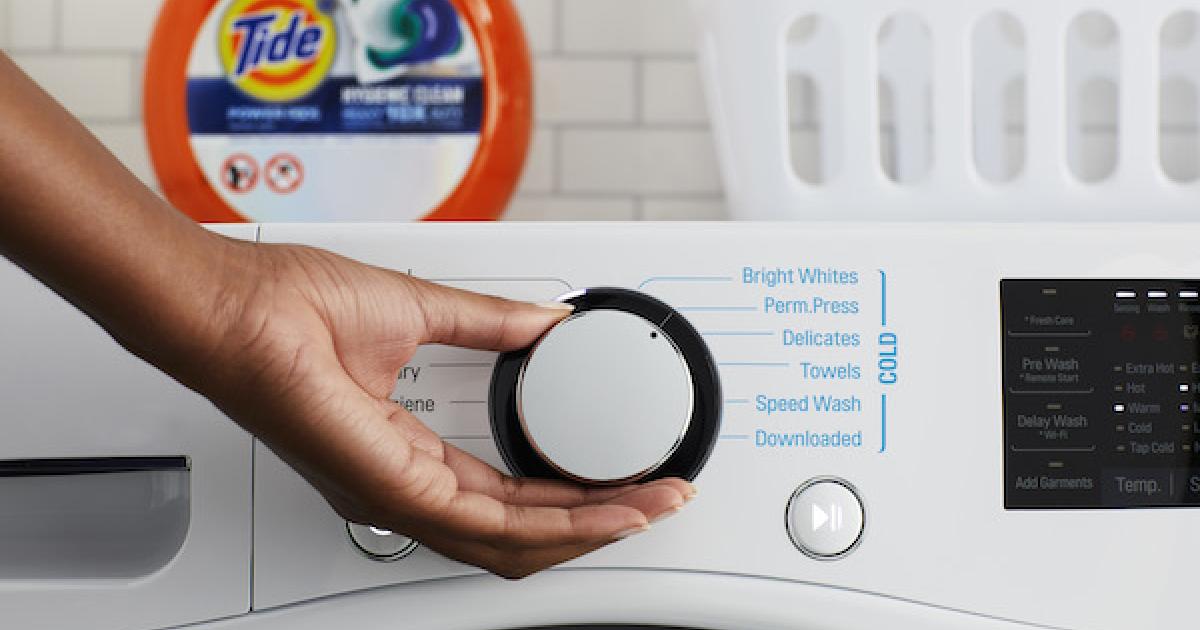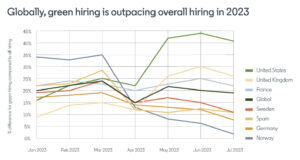
This article is sponsored by Procter & Gamble.
As companies continue to commit to and execute against mission-critical net zero plans, goals around addressing the consumer use aspects may feel far off compared to scope 1 and 2 emissions. But pushing off the consumer use phase is a mistake, as that’s often where major impact can be made.
Tide has set a goal for Americans to run three out of every four loads of laundry with cold water by 2030 — a move that would help avoid an estimated 27 million metric tons of greenhouse gas emissions, the equivalent of 10 times P&G’s annual global operations footprint.
For Tide, reducing emissions in the consumer use phase requires partnering and collaborating with consumers, which is why Tide is on a journey to unlock cold wash as the next broadly adopted eco-habit. As part of the brand’s broader effort to start a cold wash movement, Tide partnered with World Wildlife Fund (WWF) to tap its decades of experience addressing the most pressing issues facing our planet, including mobilizing consumers to make sustainable choices and Behavioral Insights Team (BIT), a behavioral science consultancy, to help us make sense of the complex nature of behavior change. Central to the partnership was a joint research study to understand behavioral tipping points and the science of habit change.
Here are our key takeaways from Tide’s cold water journey and the WWF study around what it takes to create lasting behavior change. The full research will also be made public by WWF in the coming months.
1. Include consumer use from the start to build an effective long-term sustainability strategy
Tide is on a journey to decarbonize laundry end-to-end. While Tide’s measurable Ambition 2030 goals span the value chain, including significant reductions in manufacturing and packaging, solving for consumer use is in many ways our North Star. Let me tell you why.
According to a recent report, Net Zero by 2050, by the International Energy Agency (IEA), 55 percent of emissions reductions in a pathway to carbon neutral by 2050 are linked to consumer choices. For laundry, this number is even higher with about 70 percent of Tide’s carbon footprint coming from consumer use — specifically the energy required to heat water in the wash cycle.
As Tide continues to support P&G’s overarching net-zero ambition, addressing consumer use is a critical and challenging piece of the puzzle. Tide has already made significant strides in manufacturing. Today, all Tide plants run on 100 percent renewable electricity, and we continue to explore and make progress in other areas to reduce our carbon footprint. That includes using carbon capture technology in manufacturing of raw materials, which represents our second greatest area of impact. Even as these technologies advance and scale in the near future, the consumer use phase will remain our biggest opportunity to drive impact.
2. Pull multiple levers to explore the fastest way to drive sustainable behavior change
Tide is an expert on innovating products for sustainable outcomes but driving consumer habit change around those products is a different challenge entirely. Luckily, understanding and leaning on leading behavioral frameworks can help. This was one of the goals of our joint research project, beginning with the “COM-B” model.
COM-B essentially states that to enable a new habit, you need three core elements working in concert:
- Capability: the physical or psychological ability to act
- Opportunity: cues or reminders to take action, or feeling the social acceptance to do so
- Motivation: alignment with intrinsic values or delivery of extrinsic rewards
For cold water wash, delivering on these elements means removing barriers, introducing interventions and dialing up benefits. For example, that can include working with washing machine manufacturers to make cold wash settings more easily identifiable and accessible; leveraging prompts to remind people to wash in cold water at the point of laundry via messaging on the package; supporting ongoing education and awareness campaigns sharing the benefits of cold; and redefining social norms toward cold becoming the preferred wash setting.
3. Behavior change is a collaborative journey with the consumer — listen to them at every step
When it comes to cold wash, it’s clear that consumers are motivated by different things — whether the environment, money savings, clothing longevity, cleaning performance or all the above. The good news is it doesn’t matter why the consumer makes a change, just that they do. The challenge is figuring out the message-and-messenger combinations to drive the greatest interest and impact toward habit change.
This is where testing and listening to consumers is so important. For example, we recently ran a simple ad with a straightforward money savings claim that outperformed celebrity call to actions sharing multiple benefits of cold water washing. The learning was that in this tough economic environment, a practical and focused value play has the potential to drive the greatest progress toward our sustainability goal.
4. Apply creativity to gathering data and assessing progress with consumers
There are several challenges with measuring consumer use, including the scale of the target population and the level of granularity required to collect data at the point of action. Unlike suppliers in the supply chain, the consumer can’t accurately report on how much energy they are using when washing on a cold setting. Brands must develop methodologies and systems built on the best available data at the time with flexibility to update as data quality improves.
For Tide, this meant liaising with industry associations and other key partners to consider and measure the numerous factors that affect energy savings in the wash cycle. This includes different types of machines used and energy types powering those machines. It also accounts for how these factors are expected to change over time such as through newfound efficiencies by washing machine manufacturers, consumer adoption of new machine models and greater transition to renewable energy. To estimate GHG savings, we use this model combined with studies using consumer diaries that track loads on cold.
5. Seek out partners with shared values to make lasting change
Driving behavior change at scale is an enormous task, which is why collaboration and collective action from multiple stakeholders are essential. As we continue to make cold wash the new industry standard, Tide is teaming up with like-minded organizations to continue to drive a #TurnToCold movement.
Tide’s growing coalition also includes collaboration with broad-reaching brands and organizations such as Hanes and the NFL that are on similar journeys to lower their carbon footprints and have found significant impact in cold-wash energy savings. When you’re able to find a partner with shared long-term goals and vision, the ability to unlock lasting, meaningful collaboration to go further, faster becomes much easier.
- SEO Powered Content & PR Distribution. Get Amplified Today.
- Platoblockchain. Web3 Metaverse Intelligence. Knowledge Amplified. Access Here.
- Minting the Future w Adryenn Ashley. Access Here.
- Source: https://www.greenbiz.com/article/cold-hard-lessons-tide-driving-behavior-change-scale
- :is
- $UP
- 1
- 10
- 100
- 70
- a
- ability
- Able
- About
- above
- acceptance
- accessible
- Accounts
- accurately
- Action
- actions
- Ad
- addressing
- adopted
- Adoption
- advance
- affect
- against
- agency
- All
- already
- ambition
- Americans
- and
- annual
- Apply
- ARE
- AREA
- areas
- around
- article
- AS
- aspects
- Assessing
- associations
- At
- available
- awareness
- barriers
- BE
- becomes
- becoming
- Beginning
- benefits
- BEST
- Biggest
- Bit
- brands
- broader
- broadly
- build
- built
- by
- call
- Campaigns
- CAN
- capture
- carbon
- carbon capture
- carbon footprint
- Celebrity
- central
- chain
- challenge
- challenges
- challenging
- change
- choices
- claim
- Cleaning
- clear
- Clothing
- collaborating
- collaboration
- collaborative
- collect
- Collective
- Collective Action
- combinations
- combined
- coming
- commit
- Companies
- compared
- complex
- concert
- Consider
- consultancy
- consumer
- consumer adoption
- Consumers
- continue
- continues
- Core
- create
- creativity
- critical
- cycle
- data
- data quality
- decades
- delivering
- delivery
- develop
- different
- Doesn’t
- drive
- driving
- easier
- easily
- Economic
- Education
- Effective
- efficiencies
- effort
- electricity
- elements
- Emissions
- enable
- end-to-end
- energy
- enormous
- entirely
- Environment
- Equivalent
- essential
- essentially
- estimate
- estimated
- Ether (ETH)
- Even
- Every
- example
- execute
- expected
- experience
- expert
- explore
- facing
- factors
- faster
- fastest
- Find
- Flexibility
- focused
- Footprint
- For
- found
- frameworks
- from
- full
- fund
- further
- future
- GAS
- gathering
- GHG
- Global
- Go
- goal
- Goals
- good
- greater
- greatest
- greenhouse gas
- Greenhouse gas emissions
- Growing
- Hard
- Have
- help
- higher
- How
- HTTPS
- IEA
- Impact
- important
- improves
- in
- In other
- include
- includes
- Including
- industry
- innovating
- insights
- interest
- International
- intrinsic
- introducing
- issues
- IT
- ITS
- joint
- journey
- Journeys
- jpg
- Key
- lasting
- leading
- learning
- Lessons
- Level
- leveraging
- like-minded
- linked
- Listening
- loads
- long-term
- longevity
- machine
- Machines
- made
- major
- make
- MAKES
- Manufacturers
- manufacturing
- many
- materials
- Matter
- May..
- meaningful
- means
- measure
- measuring
- messaging
- methodologies
- metric
- million
- mistake
- model
- models
- money
- months
- more
- most
- motivated
- move
- movement
- multiple
- Nature
- Near
- Need
- net
- net-zero
- Neutral
- New
- news
- next
- NFL
- North
- number
- numerous
- of
- on
- ONE
- ongoing
- Operations
- Opportunity
- organizations
- Other
- package
- packaging
- part
- partner
- partnered
- partnering
- partners
- Partnership
- People
- percent
- performance
- phase
- physical
- piece
- planet
- plans
- plants
- plato
- Plato Data Intelligence
- PlatoData
- Play
- Point
- points
- population
- potential
- Powering
- Practical
- preferred
- Products
- Progress
- project
- public
- Pushing
- puzzle
- quality
- Raw
- recent
- recently
- Redefining
- reduce
- reducing
- reducing emissions
- remain
- removing
- Renewable
- renewable energy
- report
- represents
- required
- requires
- research
- Run
- Savings
- Scale
- Science
- scope
- Second
- Seek
- sense
- set
- setting
- settings
- several
- shared
- sharing
- significant
- similar
- Simple
- So
- Social
- Solving
- span
- specifically
- Sponsored
- stakeholders
- standard
- Star
- start
- States
- straightforward
- strides
- studies
- Study
- such
- suppliers
- supply
- supply chain
- support
- Supporting
- Sustainability
- sustainable
- Systems
- Take
- Takeaways
- takes
- Tap
- Target
- Task
- team
- teaming up
- Technologies
- Technology
- Testing
- that
- The
- their
- Them
- These
- things
- three
- Through
- Tide
- time
- times
- Tipping
- to
- today
- tons
- toward
- track
- transition
- types
- understand
- understanding
- unlock
- Update
- us
- use
- value
- Values
- via
- vision
- Water
- Way..
- ways
- What
- whether
- which
- while
- Wildlife
- will
- with
- working
- world
- would
- zephyrnet
- zero







